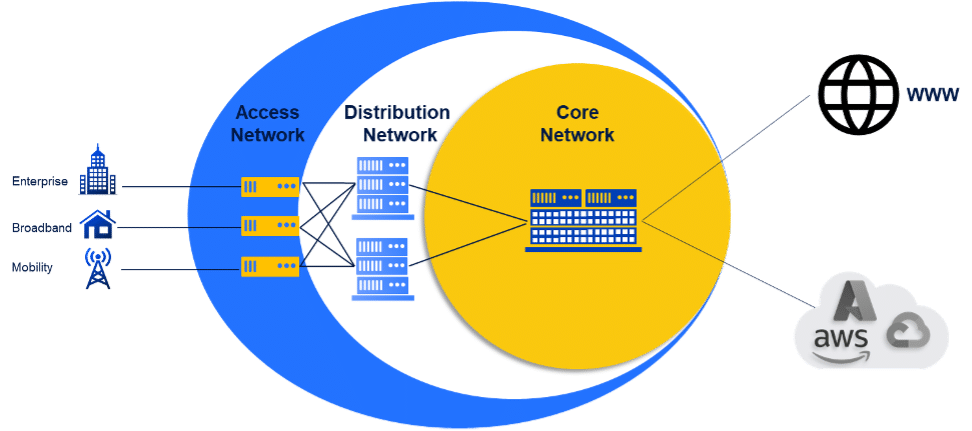What is a Core Network?
The core network (also known as the “backbone network”) is the heart of a communication network, and ensures the efficient and reliable delivery of traffic between main network nodes.
The core network provides connectivity and routing services between different parts of the network and controls the flow of traffic between these parts. For example, it connects different regions or countries and routes traffic to external networks, such as the Internet and cloud services.
The core network is designed to be very fast, reliable, scalable, and secure, and is perceived to be the most critical part of a communication network.
What Makes Up a Core Network?
A core network is a collection of network hardware, devices, and software that provides the fundamental services for a telecom organization’s needs. The devices and facilities used for the core networks are generally switches and routers. The technologies used for the core network facilities primarily include data link and network layer technologies, such as IP, asynchronous transfer mode (ATM), internet protocol (IP), synchronous optical networking (SONET), and dense wavelength division multiplexing (DWDM).
Core Network Software Explained
Due to their complexity, today’s core network deployments face several challenges, particularly around automated service activation and the management of networks. Network infrastructure diversity also poses a threat to the reliability of the broadband services offered. Therefore, core network software brings all the scattered elements together to guarantee service assurance for a telecom industry that is bursting at the seams. Core network software takes the burden off the backs of core networks by ensuring the consistent and highest possible quality of service, reducing downtime and mean time to repair, and ultimately driving customer satisfaction.
The Three Layers of Network Architecture
The core network is part of the three layers of network architecture:
- Access layer: the first layer of the network that end users connect to and provides access to the network for all devices (computers, phones, IoT, etc.).
- Distribution layer (also known as the “aggregation layer”): the layer that connects the access layer to the core layer and provides such network services as routing and traffic management.
- Core network: the layer at the center and the most important layer in a three layer network architecture. As described, the core network provides connectivity and routing services between different parts of the network.

Main Responsibilities of Core Networks
- Routing traffic: as mentioned above, the core network is mainly for routing traffic between different parts of the network. The core network typically uses a variety of networking technologies and dynamic protocols to provide improved connectivity and routing, for example, OSPF (Open Shortest Path First) and BGP (Border Gateway Protocol).
- Providing high-capacity, high-speed links: to connect and provide the necessary bandwidth to carry traffic through the network, the core network typically utilizes high-capacity, high-speed links, such as fiber optic cables.
Using Quality of Service (QoS): the core network may also use Quality of Service (QoS) protocols to prioritize and control the flow of traffic through the network. For example, Multi-Protocol Label Switching (MPLS), Resource Reservation Protocol (RSVP), and to some extent also Software-Defined WAN (SD-WAN). - Ensuring reliability: The core network is typically designed to be highly reliable and scalable, as it plays a critical role in forwarding traffic. Reliability is ensured by implementing redundant components and protocols, such as high availability (HA) and load balancing, minimizing outages or failures and distributing traffic evenly across multiple servers or devices, improving reliability and availability.
- Allowing Scalability: security is also important, as the core network must be able to accommodate the exponential growing traffic demands of the network. Solutions like the Distributed Disaggregated Chassis (DDC) can help with scalability along with efficient network segmentation, helping to reduce the impact of failures and allowing for easier network scaling.
- Applying Security: Often, cyber-attacks target the core network, making security a top priority. In order to protect against these threats, core networks typically use firewalls, DDoS protection, and other intrusion prevention measures.
The Future of Core Networks
The economic framework of the current networking infrastructure put service providers in a position where they are losing revenue to hyperscalers and internet companies leveraging OTT services and extracting key monetization tools from service providers.
Key emerging technologies like 5G, IoT, artificial intelligence, and machine learning (ML) are expected to push the need for low latency, edge computing, and distributed approaches from service providers. As a result, service providers will likely adopt virtualized networking solutions to maintain flexibility, scalability, and cost efficiency.
It is most likely that core networks will be a part of this evolution serving at the heart of every network.
DriveNets Core Networks Solution
DriveNets Network Cloud changes the way network are built. A single architecture serves all network scenarios. Based on a distributed disaggregated chassis architecture, DriveNets Network Cloud solution allows cloud and network operators evolve their core network without the limitations and constraints of past, monolithic architectures. DriveNets Network Cloud core services replace P/LSR and PE/LER mega-chassis or Clos architecture with a software-based solution, running containerized networking functions over clusters of white box scalable in size. DriveNets Network Operating System (DNOS) is a cloud-native, distributed networking software, built on containerized microservices, which creates a unified, shared infrastructure over a distributed architecture. DNOS supports multiple service offerings at scale, including routing – from core to access- and hosting for third-party services.
Additional Core Network Resources
Service Provider Routing Solutions
Brochure: DriveNets Network Cloud service provider routing solution
Case Studies
- Migrating an IP/MPLS core network to a disaggregated and distributed cluster architecture
- DIGI: Handling Peak Traffic Workloads and Streamlining Core Network Operations
Press releases
- DriveNets Network Cloud Now Carries More Than 52% of AT&T’s Core Production Traffic
- AT&T deploys DriveNets Network Cloud in their next-gen core
- DriveNets and KGPCo Partner to Lead Market Adoption of Disaggregated Core and Edge Networks at Tier 1 Communication Service Providers
White papers





